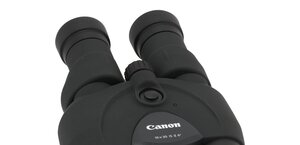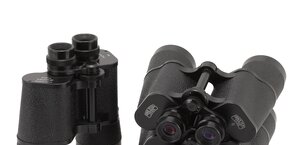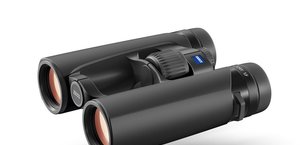Review of four 65 ED spotting scopes
3. Celestron Regal 65 F-ED – spotting scope review
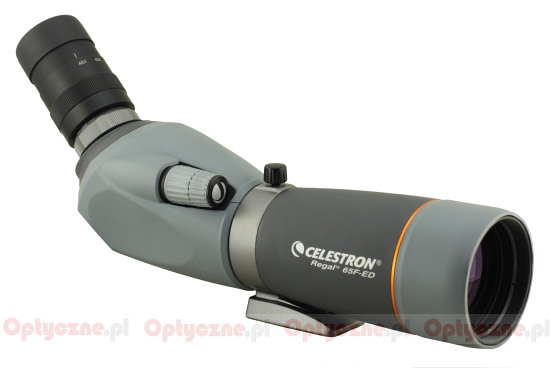 |
Design and build quality
The Celestron Regal 65 F-ED, for the class of equipment it represents, is a huge and heavy spotting scope. It’s enough to say it weighs 1730 grams and its length, without the eyepiece, is 333 mm. The device is also 10 cm wide in the thickest place. Many 80 mm spotting scopes are similar when it comes to the dimensions and physically lighter - for instance the Pentax PF 80ED-A weighs 1600 grams and is 415 mm long.
Please Support UsIf you enjoy our reviews and articles, and you want us to continue our work please, support our website by donating through PayPal. The funds are going to be used for paying our editorial team, renting servers, and equipping our testing studio; only that way we will be able to continue providing you interesting content for free. |
- - - - - - - - - - - - - - - - - - - - - - - - - - - - - - - - - - - - - - - - - - - - - - - -
Few people are as aware as ourselves that in optics big dimensions very often influence optical properties. The problem is that the spotting scopes of 60-65 mm class are should be compact and handy – it is supposed to be their main advantage. You should be able to take them with you on a trip in your backpack or put them on a small balcony without the danger of stumbling on them all the time. You must admit the Celestron Regal doesn’t fit that description at all. In its producer’s line-up there are also Regal series spotting scopes with the objective lenses of 80 and 100 mm. All of them are angled models.
The producer doesn’t provide any precise info about the optical construction of the offered equipment. One glance inside the scopes allows you to determine that we deal here, in all probability, with an air spaced doublet design in which one of elements is made of low dispersion fluorite. Inside the tube there is a focusing element (it might be an achromatic doublet). Then you have some Porro prisms behind which there is another one, directing rays of light at 45 degrees to the axis of the objective. Behind it there is one more flat, protective element.
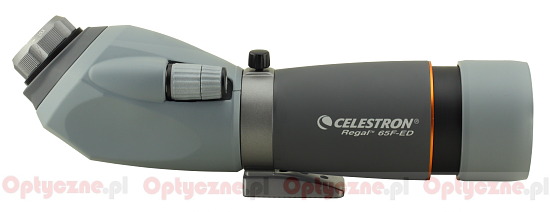 |
According to the specifications of the producer the spotting scopes features an objective lens 65 mm in diameter and a focal lens of 386 mm which gives us f/5.94 aperture. We deal here with a fast piece of equipment for which the chromatic aberration might be often bothersome. A chart below shows detailed parameters of the tested scope.
| Lens diameter: |
65 mm |
| Focal length: |
386 mm |
| Aperture: |
f/5.94 |
| Prism: |
BaK-4/Porro |
| Optical construction: |
Doublet with one fluorite element |
| Dimensions (length × width): |
333 mm × 100 mm |
| Weight: |
1730 grams |
| Price: |
1999 PLN / 990 Euro |
The body of the spotting scopes is made of metal and rubber-padded near the prisms. The tube itself is made of metal and a dew shield, which extends by two centimeters, is made of plastics. Between the dew shield and the tube there is an orange, metal ring which, after shifting the former has too much slack and move sideways. The producer emphasizes the fact that the spotting scopes are waterproof.
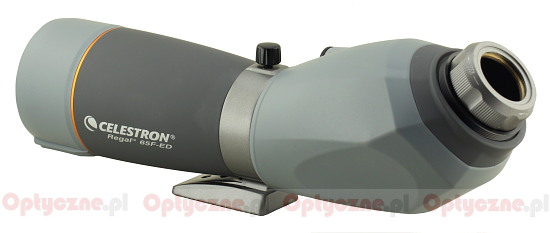 |
The ribbed focus shaft works smoothly without any squelching and is well damped. What’s important it is divided into two knobs with different gear ratio. The smaller knob allows you to set the focus in a very precise way and is very useful in many situations.
The spotting scopes are equipped with a tripod adapter with three holes of the same diameter so you can attach it to a head of a standard photographic stand. As you open the blockade by loosening a screw on the middle ring you can smoothly regulate the position of the tripod adapter.
At the end of the scopes there is an eyepiece mount with a standard diameter of 1.25 inches – it means you can use hundreds of eyepieces available on the astronomical market. The eyepiece simply slips into the extension tube and it is locked into place with a twist of a LOCK ring.
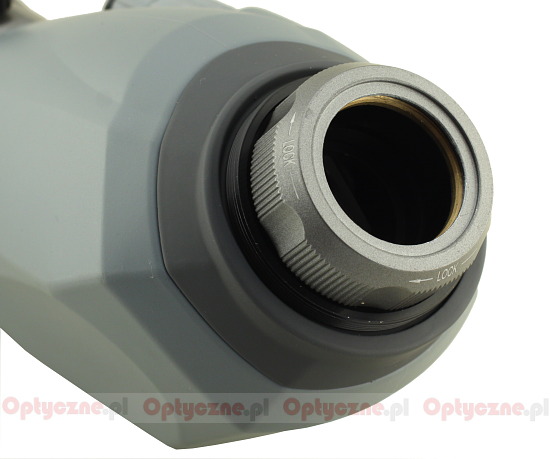 |
The tested spotting scopes didn’t have any problems with accepting any other 1.25 inches eyepieces. Below you can find a photo in which we attached to it the Pentax XW 5 mm.
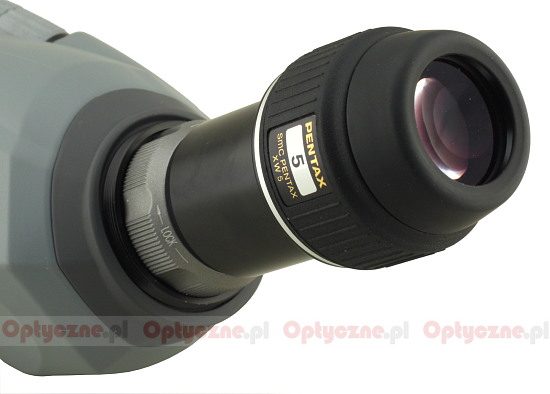 |
The producer stresses the fact that all elements are mulitcoated by antireflection layers. The coatings are really visible both from the side of the objective lens and from the side of the eyepiece. They are light greenish (their hue shifted closer to yellow compared to the Acuter) which indicates a noticeable dip in the centre of the transmission curve. Such coatings are present in a big number of spotting scopes and binoculars, produced in China nowadays. Unfortunately their intensity is significant and it bodes ill for the transmission results.
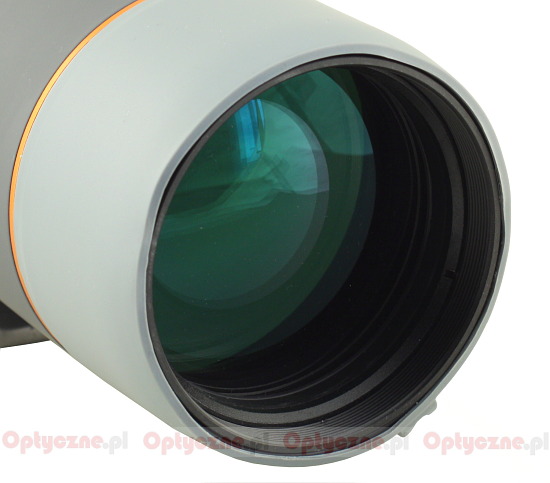 |
A closer look inside shows that the tubes are covered by black but quite shiny paint, not creating favourable conditions for damping down inner flares. Only deeper in, before the prisms, the tubes are really matt. The bottom and prism holders are more grey than black – the producer could have made a better effort here. Black, matt paint doesn’t cost a lot. The glue used to fix the prism cell is black. On the prisms we managed to notice some tiny specks of dust.
Eyepiece
The Celestron Regal spotting scope comes with a zoom 8-24 mm eyepiece. In the case of the 65 F-ED model it translates into the magnification range from 16.1 to 48.2 times and the dimension of the exit pupil varies from 4.0 to 1.3 mm. The eyepiece has its own apparent field of view, changing from 42 degrees at 24 mm focal range to 60 degrees at 8 mm. It makes the fields of view, offered by the spotting scope, change from 2.6 to 1.25 degrees. Unfortunately these 42 degrees at wide angle are not impressing. When you use it you have an impression as if you looked through a tunnel or a keyhole. Fortunately after passing to shorter focal lengths that problem disappears because a 60-degree field doesn’t produce such effects any more.
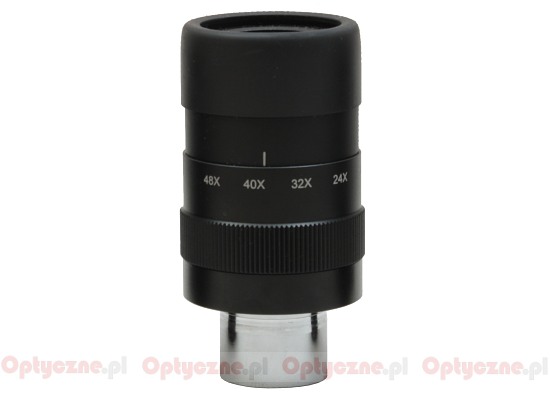 |
The eyepiece has a quite comfortable eye relief which, at 24 mm, amounts to 20 mm so even people wearing glasses will be able to conduct comfortable observations. The eyepiece which comes with the Celestron is averagely big – its maximum length (with the extended eye cup) is 105 mm, the maximum diameter is 53 mm and the weight – 320 grams. Its basic parameters are presented in a chart below.
| Focal range : |
8–24 mm |
| Field of view range: |
60–42 deg |
| Eye relief: |
20 mm at focal lenght 24 mm |
| Optical construction: |
no data |
| Dimensions (length × diameter) : |
105 mm × 53 mm |
| Weight: |
320 grams |
| Price: |
part of the accesory kit |
The photo presented below shows a comparison between the dimensions of 8-24 mm eyepieces, used in this spotting scopes test. From the left there are eyepieces added to the Pentax, the Delta Optical Titanium, the Celestron Regal and the Acuter.
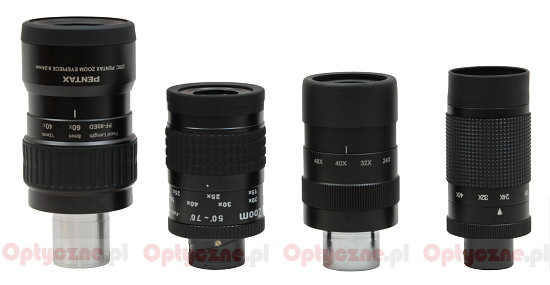 |
The eyepiece starts with an eye element with a diameter of 2.5 cm which is surrounded by a twist-up eyecup made of hard rubber. Fully extended, the eyecup is 8 mm long.
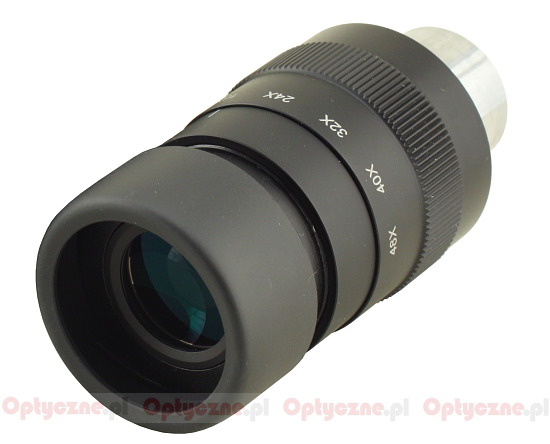 |
Behind the eyecup there is a smooth, immobile ring, 14 mm high. Then you can find a zoom ring, 32 mm wide; the ribbing takes about half of it, the other half being a place for magnification marks at 16, 24, 32, 40 and 48x. The ring moves smoothly and is well-damped. Further on there is another immobile element of the casing behind which the black coloured part ends. A silver bushing sticks out of it, 1.25 inches in diameter and 24 mm long. It houses the front element set. As the element next to your eye remains motionless during the zooming, the front element set changes its position, being the most extended at 8 mm and hiding inside the bushing by over 1 cm when you pass to the maximum focal length.
The eyepiece has dark-greenish multi coatings on almost all air-to-glass surfaces. One surface, visible very well from the side of the eye element, seems not be covered at all, though.
Vignetting
The light beam, exiting the prism set is unfortunately not directed perfectly within the central axis of the extension tube. That’s why exit pupils are noticeably truncated – we observed it in several places, like in a photo of the same exit pupil or in a photo of a ring of light coming from the prisms, taken in perfect alignment with the axis of the tube extension. What’s more, defocused images of stars are not circular - they reflect exactly the shape of the truncated pupil.
| Exit pupil | Eyepiece tube |
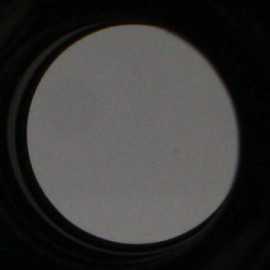
|
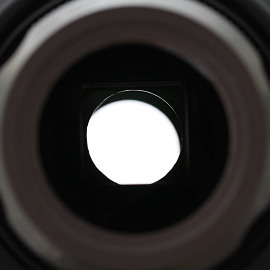
|
The photos above show how the exit pupil at the minimum magnification and the prisms look like, photographed within the axis of the eyepiece. In this case the vignetting is exactly 4.5% and so much light, diligently collected by the lens, is lost at the very start. It is obvious that the result of the Celestron is nothing to be proud of. If you also take into account the huge dimensions of the device which should allow to use big prisms without vignetting our assessment in this category can be only and entirely negative.
Inner flares
The photos below show the area near an exit pupil; they were taken at the minimum and the maximum magnification.
| Power 16x | Power 48x |
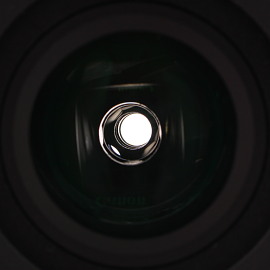
|
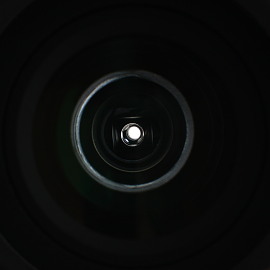
|
These images definitely don’t deserve to be praised as they are worse than in the cheaper Acuter - the number of flares at the minimum magnification is definitely too high. A lot of flares coming from the area near the prisms are visible also at the biggest magnification. Additionally you can notice a distinct ring with a significant diameter which surrounds the exit pupil.
Chromatic aberration
During a sunny day we pointed the spotting scopes at a chimney positioned against a cloudless sky. At the minimum magnification in the field of view centre the chromatic aberration is invisible. If you look at the edge of that field you can notice yellow-purple rims, similar to those of the Pentax and a bit bigger than those of the Delta. The maximum magnification doesn’t show any aberration in the centre but it appears on the edge as a visible yellow hue of the borders. The result is similar to that observed in the case of the Delta but more pronounced than that of the Pentax and not as big as that of the Acuter.
The bright Venus is always a quite demanding test so we didn’t fail to conduct it also in this case. At the maximum magnification the image we saw was definitely the nicest of all devices tested here. The disc of the planet was distinct, the chromatic aberration – negligible, visible only as a yellowish cast on the disc’s edge. A round of applause for the Celestron.
The next test was conducted on the disc of the Moon. At the minimum magnification there is no visible chromatic aberration and the face of the moon contrasts nicely with the blackness of the sky. When the object is moved to the edge of the field of view you can notice a yellow-blue rim, very similar to that observed with the Delta Optical. At the maximum magnification the situation is roughly the same. In the centre there is almost no aberration at all, on the edge we see some slight yellow colour with the addition of light blue on the other side.
The overall impressions in this category are very good - the Celestron seems to be the best of all the tested spotting scopes when it comes to the chromatic aberration correction.
Astigmatism
At the smallest magnification the astigmatism is low. If we wanted to use our binoculars tests scale, the result would be around 7-8 out of 10. It is a very similar result to that of the Delta, a bit better than that of the Pentax and noticeably better than that of the Acuter. At the maximum magnification it is the Celestron which gives the nicest point-like images of stars.
Coma
Using 16x magnification we shouldn’t worry about the coma at all. The images of stars are practically point-like to the very edge of the field of view. At the maximum magnification the result is not much worse – the coma appears only near 90% of the field of view radius and on the very edge that aberration remains still low. In this category the tested spotting scope definitely deserves to be praised.
Distortion
At 16x we can observe slight pincushion distortion which decreases with the rise of the magnification ratio. At 48x that aberration is low but still a bit higher than e.g. in the case of the Acuter.
Blurr on the edge of the field
At the lowest magnification the image is sharp already from about 80% of the field of vision radius; then the image quality starts to decrease. At the maximum focal length for a change a very good resolution is kept practically to the very end of the field. Here the Celestron fares better than the Acuter and the Delta but worse than the Pentax.
Accessories
Buyers get a soft protective case and a threaded adapter for a T2 thread – it can be attached instead of the eyecup and you can take photos in the eyepiece projection mode.
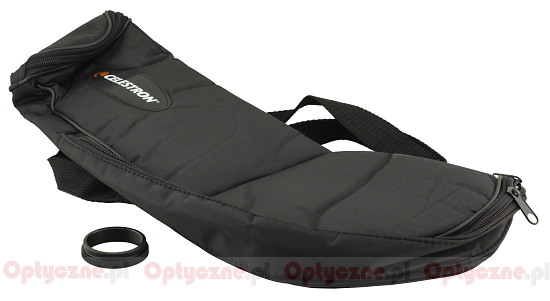 |
Summary
Pros:
- fluorite glass in the eyepiece,
- negligible astigmatism,
- very well corrected chromatic aberration,
- brilliantly corrected coma,
- slight distortion,
- at bigger magnifications the image is sharp practically to the every edge of the field of view,
- focus wheel divided into two knobs with a different gear ratio,
- standard 1.25 inches eyepiece exit.
Cons:
- high intensity of anti-reflection coatings,
- truncated exit pupil,
- a lot of flares near exit pupils,
- significant weight and dimensions.
The Celestron Regal is undoubtedly the best spotting scope of our test when it comes to the optics. What’s interesting, it is even better than more expensive and very prestigious Pentax. Unfortunately there is no rose without a thorn. Great optical properties are partially due to fluorite glass and partially to significant dimensions – so significant that, in fact, you can compare them to any of the 80-85 class spotting scopes. If you aren’t bothered by those dimensions and the weight of this instrument and you can additionally turn a blind eye to some minor shortcomings, concerning the build quality, the Regal will be a very good choice.
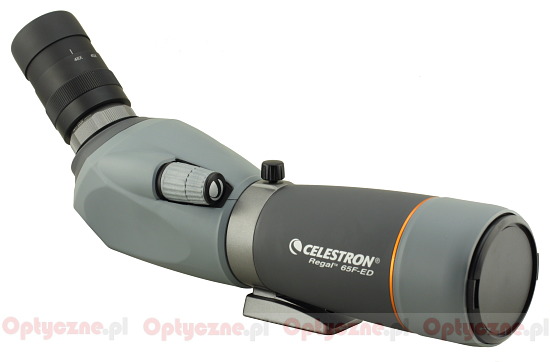 |




